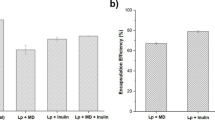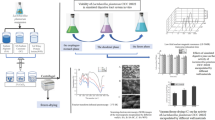Abstract
Lactobacillus acidophilus, as a probiotic, is widely used in many functional food products. Microencapsulation not only increases the survival rate of L. acidophilus during storage and extends the shelf-life of its products, but also optimal size microcapsule makes L. acidophilus have an excellent dispersability in final products. In this paper, L. acidophilus was microencapsulated using spray drying (inlet air temperature of 170°C; outlet air temperature of 85–90°C). The wall materials used in this study were β-cyclodextrin and acacia gum in the proportion of 9:1 (w/w), and microcapsules were prepared at four levels of wall materials (15, 20, 25 and 30% [w/v]) with a core material concentration of 6% (v/v). The microcapsule diameters were measured by Malvern’s Mastersizer-2000 particle size analyzer. The results showed that the particle diameters of microcapsule were mostly within 6.607 μm and 60.256 μm and varied with 2.884–120.226 μm (the standard smaller microcapsule designated as <350 μm). Through comparison of microcapsule size and uniformity with different concentration of wall materials, we concluded that the optimal concentration of wall material was 20% (w/v), which gave microcapsule with a relatively uniform size (averaging 22.153 μm), and the number of surviving encapsulated L. acidophilus was 1.50 × 109 c.f.u./ml. After 8 weeks storage at 4°C, the live bacterial number was above 107 c.f.u./ml, compared with unencapsulated L. acidophilus, 104–105 c.f.u./ml. Through the observation of scanning electron microscopy, we found that the shapes of microcapsule were round and oval, and L. acidophilus cells located in the centre of microcapsule.


Similar content being viewed by others
References
Alm L (1991) The therapeutic effects of various cultures-an overview: therapeutic properties of fermented milks. New York: Elsevier Appl Sci 21:45–64
Anjani K, Kailasapathy K, Phillips M (2007) Microencapsulation of enzymes for potential application in acceleration of cheese ripening. Int Dairy J 17(1):79–86
Arshady R (1993) Microcapsules for food. J Microencapsul 10(4):413–435
Baruch L, Machluf M (2006) Alginate-chitosan complex coacervation for cell encapsulation: effect on mechanical properties and on long-term viability. Biopolymers 82(6):570–579
Beatus Y, Raziel A, Rosenberg M, Kopelman IJ (1985) Spray-drying microencapsulation of Paprika oleoresin. Lebensmittel-Wissenschaft & Technologie 18(1):28–34
Bhandari BR, D’Arcy BR, Padukka I (1999) Encapsulation of lemon oil by paste method using beta-cyclodextrin: encapsulation efficiency and profile of oil volatiles. J Agric Food Chem 47(12):5194–5197
Chan LW, Lim LT, Heng PWS (2000) Microencapsulation of oils using sodium alginate. J Microencapsul 17(6):757–766
Chang YI, Scire J, Jacobs B (1988) Effect of particle size and microstructure properties on encapsulated orange oil. ACS Symp Ser 370:87–102
Fu HL (2004) Practical technique of electron microscope. High Education Press, Beijing
Fuller R (1991) Probiotics in human medicine. Gut 32:439–442
Kailasapathy K (2006) Survival of free and encapsulated probiotic bacteria and their effect on the sensory properties of yoghurt. LWT-Food Sci Technol 39(10):1221–1227
Kim HS, Kamara BJ, Good IC (1988) Method for the preparation of stabile microencapsulated lactic-acid bacteria. J Ind Microbiol 3(4):253–257
Krasaekoopt W, Bhandari B, Deeth HC (2006) Survival of probiotics encapsulated in chitosan-coated alginate beads in yoghurt from UHT- and conventionally treated milk during storage. LWT-Food Sci Technol 39(2):177–183
Kurmann JA, Rasic JL (1988) Technology of fermented special products. Bull Int Dairy Federation (IDF) 227:101–104
McNamee BF, O’Riordan ED, O’Sullivan M (1998) Emulsification and microencapsulation properties of gum Arabic. J Agric Food Chem 46(11):4551–4555
Moreau DL (1991) Physical properties and porosity of whey protein-based microcapsules. UMI Company, Michigan, pp 22–26, 41–43, 156–159
Muthukumarasamy P, Allan-Wojtas P, Holley RA (2006) Stability of Lactobacillus reuteri in different types of microcapsules. J Food Sci 71(1):M20–M24
Posillico EG (1986) Biotechnology. Wiley Press, NewYork, pp 114–117
Robitaille R, Pariseau JF, Leblond FA (1999) Studies on small (<350 μm) alginate-poly-L-lysine microcapsules. III. Biocompatibility of smaller versus standard microcapsules. J Biomed Mater Res 44(1):116–120
Rosenberg M, Kopelman IJ, Talmon Y (1985) A scanning electron-microscopy study of microencapsulation. J Food Sci 50(1):139–144
Sharma S, Mittal A, Gupta VK (2007) Improved stabilization of microencapsulated Cathepsin B in harsh conditions. Enzyme and Microb Technol 40(2):337–342
Sheu TY, Rosenberg M (1995) Microencapsulation by spray-drying ethyl caprylate in whey-protein and carbohydrate wall systems. J Food Sci 60(1):98–103
Song J, Liu DZ, Zhang TY (1999) Improvement on the microcapsule and microencapsulation. Chem Ind Eng Prog 15(1):42–44
Sun JL, Zhao RX, Wang DH, Niu SY (2006) Study on vacuum spray dehydration micro-encapsulation of Lactobacillus acidophilus. Trans Chin Soc Agric Eng 22(5):161–164
Tannock GW (2002) Probiotics and prebiotics—where are we going? Caister Academic Press, Wymondham, pp 22–28
Vilstrup P (2001) Microencapsulation of food ingredients. Leatherhead Food RA Publishing, Leatherhead
Xie YL, Zhou HM, Qian HF (2006) Effect of addition of peach gum on physicochemical properties of gelatin-based microcapsule. J Food Biochem 30(3):302–312
Xu JX, Zhao MM, Peng ZY (1998) Study on Spirillum microencapsulation. Sci Technol Food Ind 4:13–14
Zhao RX, Li YR, Sun JL (2002) Study on the production properties of Lactobacillus acidophilus. J Northwest Sci-Tech Univ Agric For 30(3):85–88
Zhao RX, Sun JL, Yu T (2005) Preparation of functional fast fermented milk of Lactobacillus acidophilus. Food Sci Technol 2:71–74
Zhao RX, Wang DH, Sun JL, Niu SY (2006) Thermal stability and thermodynamics of Lactobacillus acidophilus. Trans Chin Soc Agric Eng 22(10):222–225
Zhao RX, Sun JL, Mo HZ, Zhu Y (2007) Analysis of functional properties of Lactobacillus acidophilus. World J Microbiol Biotechnol 23(2):195–200
Author information
Authors and Affiliations
Corresponding author
Rights and permissions
About this article
Cite this article
Zhao, R., Sun, J., Torley, P. et al. Measurement of particle diameter of Lactobacillus acidophilus microcapsule by spray drying and analysis on its microstructure. World J Microbiol Biotechnol 24, 1349–1354 (2008). https://doi.org/10.1007/s11274-007-9615-0
Received:
Accepted:
Published:
Issue Date:
DOI: https://doi.org/10.1007/s11274-007-9615-0




